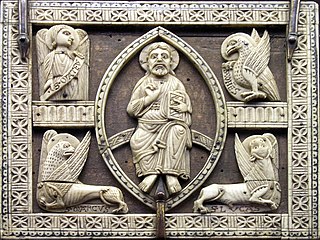Mandorla

Mandorla ( Italian for “almond”) is a technical term from art history and describes a glory or aura (“ aureole ”) around a whole figure. This is how the mandorla differs from the halo , which only surrounds the head. With a few exceptions, mandorls are reserved for Christ and show him in the type of Majestas Domini or as a pantocrator .
to form

A mandorla is mostly almond-shaped, but sometimes - especially with early forms - it can also take on a circular or elliptical shape. In very rare, also mostly early cases, the mandorla is also formed from two intersecting circles. Diamond-shaped and serrated mandorels also occur. Complex mandorels are often very prominent on icons , especially in the newer Greek style from around 1900.
The frame of a mandorla is often graduated in color or has a particularly elaborate sculptural design ( diamond rod , perforated rod, etc.); it thus recalls the vision of a rainbow in Ez 1.26–28 EU . The interior of most mandorls is undesigned; sometimes the Greek letters Α and Ω are found , more rarely depictions of a starry sky or hints of clouds.
The Romanesque mandorels are often surrounded by the symbols of the four evangelists . In many cases they are also held or lifted up by angels and are then iconographically related to the ascension of Christ or Mary.
history

Mandorls have appeared in sacred art in Europe since the 5th century AD. They experience their heyday in medieval cabaret ( book illumination , goldsmithing , ivory carving ), in apse frescoes or in the Romanesque tympana portal . They are rarely found in Gothic and late Gothic art; Apart from a few exceptions (e.g. Perugino 's images of the Ascension, Raffael's Disputa ), the artists of the High Renaissance did without the depiction of mandorels or replaced them with halos, cloud shapes, etc. They disappeared completely in the late Renaissance and Baroque periods. It was not until the Pre-Raphaelites and Nazarenes , who orientated themselves on medieval art , that they reappear in isolated cases in the 19th and 20th centuries.
Mary in the mandorla
It is rare that the Mother of God appears alone in a mandorla; if so, then mostly the subject of the Assumption of Mary is addressed. More often she appears together with her son in the type of the Coronation of the Virgin or as Sedes sapientiae ("seat of wisdom"). In late Gothic art, the independent type of radiant wreath Madonna developed without a mandorla, which persisted into the Baroque period.
Saints in the mandorla
Important saints in church history are also - but only in extremely rare cases - surrounded by a mandorla, which is sometimes surrounded or carried by angels and in such cases corresponds to the ascension type.
Emperor Otto III. in a mandorla

Famous and unique is an illumination from the Liuthar Gospel (around 1000) depicting Emperor Otto III. in a mandorla. Even if the book and gesture of blessing are missing and the emperor “only” holds the imperial orb in his outstretched, all-encompassing hands, it is as if the enthroned - and crowned by a heavenly hand - emperor is here in a Christ-like manner surrounded by the symbols of the four evangelists . Also in a representation in the Speyer Gospel (around 1045) the heads of Konrad II and his wife Gisela protrude into the mandorla, d. H. into the heavenly sphere (see picture gallery).
Such representations from the run-up to the investiture dispute can only be understood if one understands the emperor not only as a secular, but also as a spiritual representative of Christ or God on earth - a role that, according to medieval understanding, was reserved for the Pope and the Church alone.
symbolism
Mandorls are interpreted - like halos - as a visible expression of the light or healing power of a divine or quasi-divine figure; they are symbols of the medieval understanding of God and the world.
literature
- Robert Berger: The representation of the enthroned Christ in Romanesque art (= Tübingen research on archeology and art history. Vol. 5, ISSN 0175-9183 ). Gryphius, Reutlingen 1926.
- Engelbert Kirschbaum et al. (Ed.): Lexicon of Christian Iconography. Volume 3 Herder-Verlag, Freiburg (Breisgau) 1971, p. 147f, ISBN 978-3-451-22568-0 .
Web links
Remarks
- ↑ For example in frescoes by Albert Burkart in Memmingen, parish church St. Josef (1943), and in Großhesselohe, parish church Heiligste Dreifaltigkeit (around 1952?).